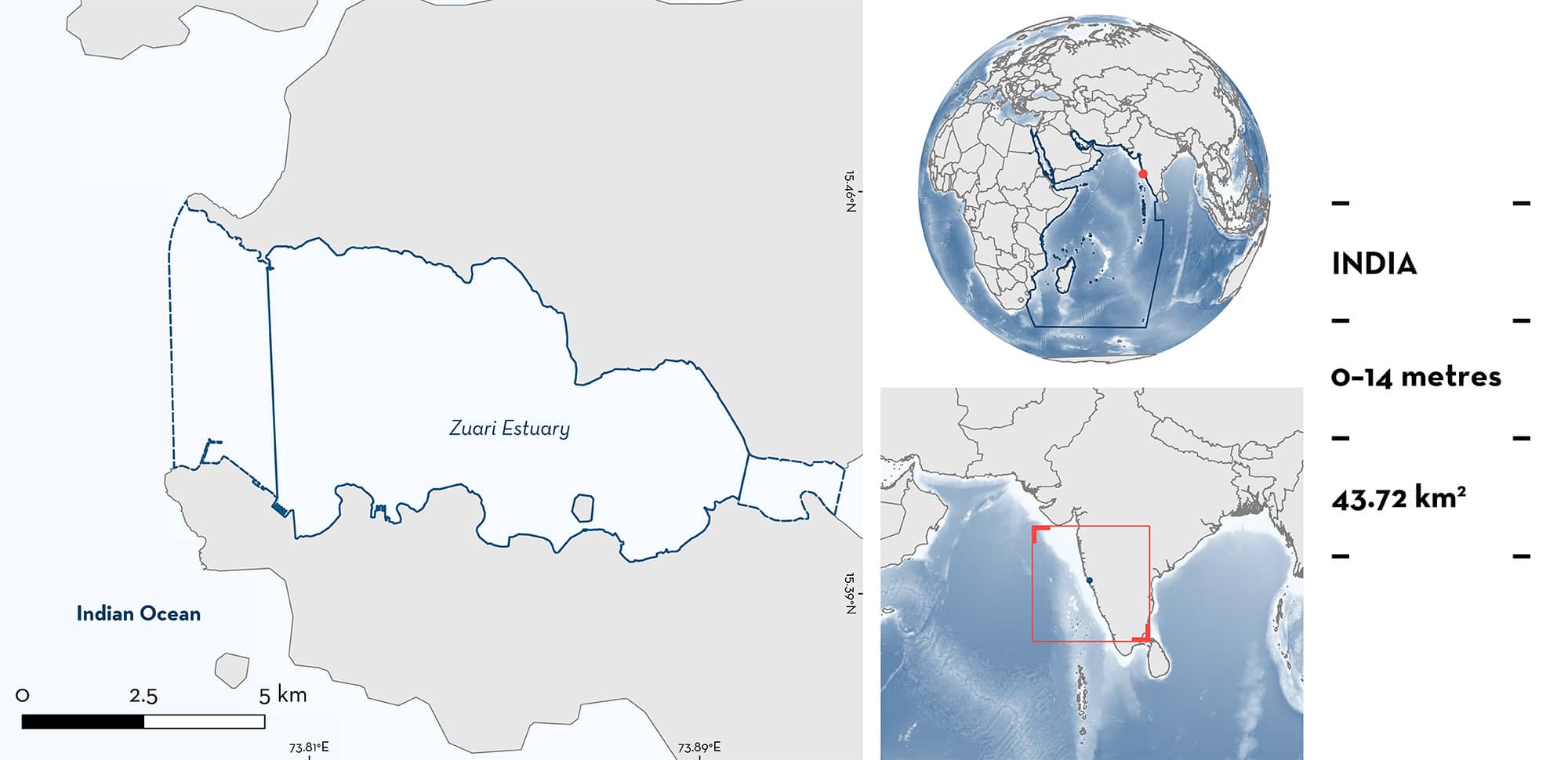ISRA FACTSHEETS
ISRA FACTSHEETS
WESTERN INDIAN OCEAN REGION
Zuari Estuary
Summary
Zuari Estuary is located in the state of Goa on the west coast of India. This dynamic estuarine system is under the influence of the monsoonal wet/dry seasonal cycle. During the dry season, salinity is higher as marine waters of the Arabian Sea penetrate the area while in the wet season, freshwater flow from the Zuari River drives down salinity. The area is characterised by shallow waters, mangroves, and extensive mudflats. Within the area there are: threatened species (e.g., Bleeker’s Whipray Pateobatis bleekeri); range restricted species (e.g., Sharpnose Guitarfish Glaucostegus granulatus); and reproductive areas (Sharpnose Guitarfish).
Download factsheet
Zuari Estuary
DESCRIPTION OF HABITAT
Zuari Estuary is a dynamic estuarine area in Goa on the west coast of India. The Zuari River flows into and heavily influences the estuary which has a mean width of 2.5 km (Giri Bhavan et al. 2023). The area is characterised by shallow waters, with the estuary naturally < 7 m deep. A dredged shipping channel at Marmugao Port is maintained at ~14 m depth. Substrate is mostly composed of mud and habitats are dominated by mangroves and extensive mudflats.
The estuary is influenced by the annual monsoon cycle with prominent dry and wet seasons. This results in seasonal fluctuations in salinity, turbidity, temperature, and nutrients (Qasim & Sen Gupta 1981; Ansari et al. 1995; Giri Bhavan et al. 2023). The dry season is characterised by low rainfall and as a consequence, the estuary is more heavily influenced by the intrusion of marine waters from the Arabian Sea (Qasim & Sen Gupta 1981; Ansari et al. 1995). During the wet season, freshwater flow from the Zuari River increases, causing the salinity of the estuary to decrease. In one study, salinity varied from 24.1 ± 4.6 in the wet season to 30.1 ± 2.1 in the dry season (Giri Bhavan et al. 2023). The upper reaches of the estuary have higher turbidity than the lower reaches and the mouth (dry season, 29.4 ± 3.2; wet season, 37.9 ± 2.5; Giri Bhavan et al. 2023).
This Important Shark and Ray Area is benthic and is delineated from inshore and surface waters (0 m) to a depth of 14 m based on the bathymetry of the area.
CRITERION A
VULNERABILITY
Two Qualifying Species considered threatened with extinction according to the IUCN Red List of Threatened SpeciesTM regularly occur in the area. These are the Critically Endangered Sharpnose Guitarfish (Kyne et al. 2022) and Endangered Bleeker’s Whipray (Sherman et al. 2020).
CRITERION B
RANGE RESTRICTED
The area holds the regular presence of Sharpnose Guitarfish and Bleeker’s Whipray as resident range-restricted species. These species occur during both the wet and dry seasons, although they are more abundant during the dry season (Giri Bhavan et al. 2023). These species have been recorded across multiple years (e.g., surveys in 2018, 2019) demonstrating their regular occurrence in the area (Sreekanth et al. 2020; Giri Bhavan et al. 2023). These two species are often recorded in lower numbers in other areas of western India than in Zuari Estuary (e.g., Johri et al. 2021; Purushottama et al. 2022).
Sharpnose Guitarfish occur in the Red Sea Large Marine Ecosystem (LME) and the Arabian Sea LME and Bleeker’s Whipray occurs in the Arabian Sea LME and the Bay of Bengal LME.
CRITERION C
SUB-CRITERION C1 – REPRODUCTIVE AREAS
Zuari Estuary is an important reproductive area for one ray species.
Sharpnose Guitarfish neonates and young-of-the-year individuals have been recorded in the area during both the dry and wet season. Forty-eight individuals were recorded during gillnet surveys in January–March 2018 (dry season), August–September 2018 (wet season), January–March 2019 (dry season), and August–September 2019 (wet season). Of these, 44 (92%) were recorded in the dry season and measured 35.5–60.8 cm total length (TL) and four were recorded in the wet season measuring 54.1–61.5 cm TL (Giri Bhavan et al. 2023). Smaller individuals were therefore recorded in the dry season. The size-at-birth of the species is ~39 cm TL (Moore et al. 2012) indicating that these animals were either neonates or young-of-the-year. All 48 individuals recorded were juvenile.
Download factsheet
SUBMIT A REQUEST
ISRA SPATIAL LAYER REQUEST
To make a request to download the ISRA Layer in either a GIS compatible Shapefile (.shp) or Google Earth compatible Keyhole Markup Language Zipped file (.kmz) please complete the following form. We will review your request and send the download details to you. We will endeavor to send you the requested files as soon as we can. However, please note that this is not an automated process, and before requests are responded to, they undergo internal review and authorization. As such, requests normally take 5–10 working days to process.
Should you have questions about the data or process, please do not hesitate to contact us.


